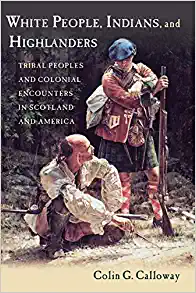 In researching the final book in the MacKay Mystery series, I delved more into the relationship between the Native Americans and the Highlanders arriving in the colonies. I had always heard these two cultures identified similarities in each other and worked well together, often intermingling. But I had no research to support these theories.
In researching the final book in the MacKay Mystery series, I delved more into the relationship between the Native Americans and the Highlanders arriving in the colonies. I had always heard these two cultures identified similarities in each other and worked well together, often intermingling. But I had no research to support these theories.
Google searches bring up a wide range of articles and opinions on the topic. But one book, in particular, caught my eye; White People, Indians, and Highlanders by Colin G. Calloway. My first thought was, wow, what a title. Highlanders separated from white people? However, the introduction to the book reveals the source of the title.
In the 1730s, James Oglethorpe, representing the British Crown, sailed on the Anne with 114 people to establish the colony of Georgia. They landed at what is now Savannah. Having lived in that city for a time, I saw the Oglethorpe name everywhere. When the English fought against the Spanish of Florida, General Oglethorpe referred to his forces as “white people, Indians, and highlanders,” offering no explanation as to why the Scots were not included with the “white people.” It seems even he recognized the commonalities between these people.
Both cultures had been described at various times as barbarian, savage, and primitive. Some even referred to them as lazy and in need of improvement. At the beginning of the Seven Years’ War, the commander of the British Forces observed the Native’s reaction to the Black Watch regiment. He stated that “the Black Watch were more likely than any other troops to get along with Indians because the Indians have an opinion that they (the Black Watch) are a kind of Indian.” They saw them as cousins of an ancient ancestral line.
 Further, in 1773, Chief Oconostota of the Cherokee was inducted into the Saint Andrews Club of Charles Towne, South Carolina. Scotsman Alexander Cameron, it is said, lived among the Cherokee so long he became one of them. Many of those Cherokee later carried his bloodline.
Further, in 1773, Chief Oconostota of the Cherokee was inducted into the Saint Andrews Club of Charles Towne, South Carolina. Scotsman Alexander Cameron, it is said, lived among the Cherokee so long he became one of them. Many of those Cherokee later carried his bloodline.
Robert MacDougall, author of Emigrant’s Guide to North America, written in Gaelic, believed he saw similarities in the languages. He described the “slow, soft, pleasant speech” he heard amongst the Algonquian tribes of Canada as merely a branch of the Gaelic. He explicitly cites words such as saganash (Algonquin for white man) with the Gaelic Sassenach (Englishman). It makes you wonder.
And in many ways, their beliefs were similar. Calloway’s book talks about a man from Skye, who, in the 1770s, claimed, “I grow out of this ground.” Similarly, Canasatego, an Iroquois, addressing colonial delegates in 1774, declared, “Our ancestors came out of this very ground, and our children have remained here ever since.” Both nations believed in the connection with the earth and the spirituality of the place. Their cultures are full of oral tales of their histories told by the bards. They identify the landscapes and understand the richness of the meaning in the names of places that bind them to the location. These tales of the land also explained the interdependence of people, animals, and the natural world. The Gaelic term duthchas refers to the clan members’ belief that they held a permanent stake in their homeland.
The Runrig system of farming, where the highlanders lived in clachans, or communities, held the arable lands in common. The clan chief oversaw the working of the system, displayed his generosity, and provided for defense. We see this in both cultures. However, by the 18th and 19th centuries, this system was viewed as standing in the way of progress.
The Gaelic clann, meaning family, implied kinship. Though this kinship may be more fictional than true, it still represented an emotional bond of descent from a common ancestor. The same applies to Native American tribes, where the association was often more social than biological. The chiefs, on both sides of the Atlantic, were expected to act for the good of their people, and the people held them to this.
There are many ways in which these cultures were similar, and it appears they saw these traits in each other. Over time, both were colonized and removed from their ancestral lands. It’s funny how in time, both cultures were romanticized in later literature.
While I am an American, I can trace my ancestry to Scotland, Ireland, Wales, and England. I even found a marriage to a Native American. But in my case, it was a Welshman who married a native woman. In the minimal records, I have discovered, she is merely called Prudence, an Indian.
